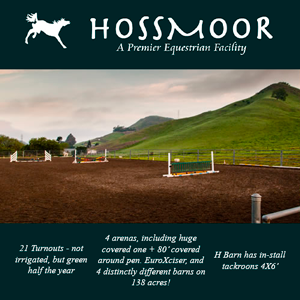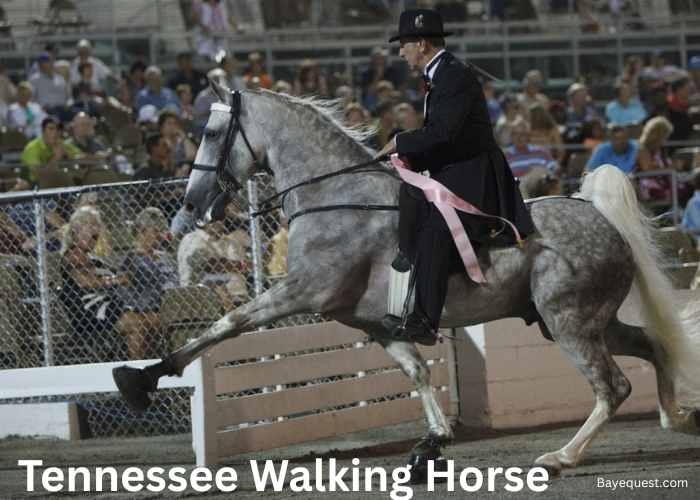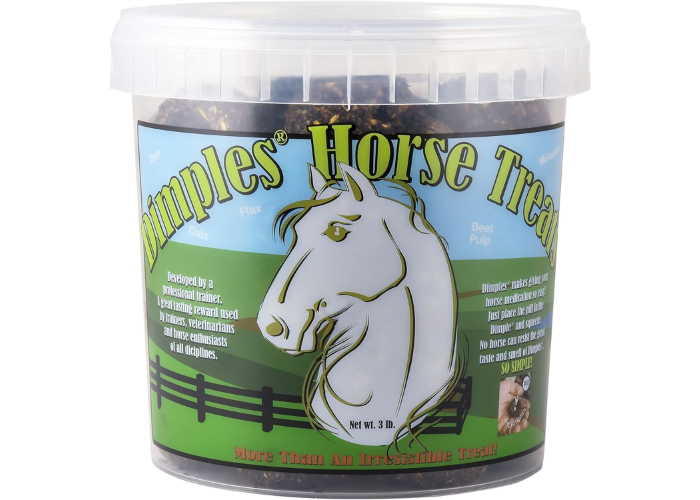The Tennessee Walking Horse was born in the hills of Tennessee, for distance and strength that lasts.
This horse is a beauty and a workhorse with style. That famous running walk is more than a gait; it’s a signature.
Long before it turned heads in show rings, it was hauling gear, covering miles, and doing it all with grace. This breed earned its fame the hard way, on trails, in fields, and under saddle.
Ready to meet the horse that walks its path? Let’s dive into its story.
Tennessee Walking Horse Origin: Key Takeaway
The Tennessee Walking Horse is an American breed developed in the late 1800s in Tennessee. It was created by crossing horses like the Narragansett Pacer, Morgan, and Standardbred. Bred for comfort and endurance, it served farmers who needed a smooth-riding, all-purpose horse for long days of work and travel.
Tennessee Walking Horse Origin
The Tennessee Walking Horse was born out of necessity and perfected through time. In the late 1800s, Southern farmers needed a horse to work the fields by day and carry them comfortably for miles by night.
The solution? A blend of breeds like the Narragansett Pacer, Canadian Pacer, Standardbred, and Morgan. Each was chosen for stamina, smooth gait, and gentle nature.
By the early 1900s, this mix produced a horse with a natural “running walk” that felt more like floating than trotting.
It wasn’t long before the breed earned its name and a reputation that would trot far beyond Tennessee’s borders.
History of the Tennessee Walking Horse
The Tennessee Walking Horse started on Southern farms in the late 1800s. Farmers needed a horse that could work hard and ride smooth.
They crossed several breeds, including the Narragansett Pacer, Morgan, Standardbred, and Thoroughbred. The result was a strong, gentle horse with a smooth gait.
In 1935, breeders formed an official registry. By 1950, the breed became a star in the show ring.
What began as a farm helper became one of America’s most beloved riding horses. Its legacy still runs strong today.
Breeds that Shaped the Tennessee Walking Horse
The Tennessee Walking Horse didn’t just happen. It was carefully created by mixing several other breeds. Each one brought something special to the mix.
The Narragansett Pacer was one of the first. This breed had a smooth, four-beat gait that passed on to the Tennessee Walker. It helped give the horse its famous “running walk.”
Next came the Canadian Pacer, known for its strength and stamina. It added endurance and a calm attitude, both perfect for long rides.
The Standardbred brought speed and a strong work ethic. Farmers needed a horse that could do more than look pretty. The Standardbred helped with that.
The Morgan breed added a compact build and friendly nature. Morgans are known for being smart and versatile. That helped shape the Tennessee Walker into a kind and easy-to-train horse.
Finally, the Thoroughbred gave the breed height, elegance, and a bit of flash for the show ring.
All of these breeds worked together to create a horse that was strong, smooth, and stylish.
The Tennessee Walking Horse wouldn’t be what it is today without them. Every step it takes carries the history of those who came before.
Key Milestones and Figures in the Tennessee Walking Horse Development
The story of the Tennessee Walking Horse is filled with important moments and key people who shaped the breed.
One major milestone came in 1935, when the Tennessee Walking Horse Breeders’ Association was formed. This group created official standards and helped promote the breed across the country.
In 1947, the first Tennessee Walking Horse National Celebration was held in Shelbyville, Tennessee. It became the biggest event for the breed and still draws large crowds every year.
A key figure in the breed’s early development was James R. Brantley, a breeder who owned Black Allan (Allan F-1), the foundation sire. His careful breeding choices laid the groundwork for the smooth gait and strong build we see today.
Another important horse was Roan Allen, a grandson of Black Allan. He passed on the desirable running walk and became a top sire in his own right.
Over time, trainers, breeders, and riders all played a part in spreading the Tennessee Walker’s fame. Their hard work turned a farm horse into a show-ring star and a national treasure.
Each milestone brought the breed closer to the graceful, reliable horse we know and love today.
The Role of Black Allan (Allan F-1) in Tennessee Walking Horse Breeding
Black Allan, also known as Allan F-1, is the foundation sire of the Tennessee Walking Horse. He was born in 1886 and was a cross between a Standardbred sire and a Morgan dam.
At first, breeders didn’t know what to make of him. He wasn’t a fast trotter like they hoped, but he had something better: a smooth, natural gait.
He showed a graceful, gliding walk that set him apart. That gait became the signature of the Tennessee Walking Horse.
Black Allan also passed down a calm, gentle temperament, which the breed is still known for today.
Most modern Tennessee Walking Horses can trace their bloodlines back to him. Though he wasn’t a superstar in his time, his legacy is massive.
Without Black Allan, the Tennessee Walking Horse would not exist as we know it.
He didn’t win races. He didn’t grab headlines. But he shaped a breed that would become world-famous for its ride.
Tennessee Walking Horse Genetics
The Tennessee Walking Horse has a unique mix of genetics that gives it its smooth gait, strong build, and calm nature.
Its DNA blends several older breeds. Each breed added traits like endurance, elegance, and that signature “running walk.”
One key genetic trait is the ability to perform a four-beat gait naturally. This gait is smoother than a trot and makes the ride more comfortable.
The gait is inherited, meaning it’s passed down through specific genes.
Researchers have even identified a gene called DMRT3, the “gait keeper” gene. Horses with this gene will likely perform smooth, intermediate gaits like the running walk.
In addition to gait, Tennessee Walkers have strong bones, well-muscled bodies, and calm temperaments. These traits have been carefully preserved through selective breeding.
Modern breeders still focus on these genetic strengths while avoiding health issues. The goal is to maintain the breed’s famous smooth ride, sound structure, and gentle nature.
Tennessee Walking Horse genetics continue to shape one of America’s most iconic riding horses.
Cultural Impact and Legacy of the Tennessee Walking Horse
The Tennessee Walking Horse is a symbol of Southern tradition and American pride.
Once a trusted partner on farms, this horse quickly became a favorite in parades, trail rides, and show rings. Its smooth gait made it ideal for long hours in the saddle, earning the love of working farmers and casual riders.
In the South, especially Tennessee, the breed became a cultural icon. Events like the Tennessee Walking Horse National Celebration turned it into a local legend and a source of community pride.
Its elegant style and calm nature made it popular in movies, festivals, and ceremonial events. Even presidents have ridden Tennessee Walkers.
Beyond fame, the horse’s legacy lives on in its loyal fan base. Riders of all ages enjoy its comfort and gentle spirit. Breeders continue to protect the breed’s quality and history.
Despite past controversies in the show world, many now focus on ethical training and preserving the true nature of the breed.
Today, the Tennessee Walking Horse symbolizes beauty, endurance, and tradition.
Tennessee Walking Horse Characteristics
The Tennessee Walking Horse stands out for more than its smooth ride. From its strong build to its gentle nature and unique gaits, this breed offers a complete package for riders of all levels.
Here’s a closer look at the key traits that define this remarkable horse.
Conformation
The Tennessee Walking Horse has a strong and balanced body. It has a long neck, sloping shoulders, and a short, sturdy back. Its chest is deep, and the legs are clean and straight.
The hindquarters are powerful and give the horse its smooth, gliding movement. These features make it attractive and useful.
Its body helps it stay comfortable during long rides. The shape also supports its natural gait. This build is one reason the breed is so popular for riding.
Colors
This horse comes in many different colors.
Common ones include black, bay, chestnut, gray, and palomino. You can also find rare colors like buckskin or cremello.
Some have white markings or unique coat patterns like tobiano or sabino. The wide variety makes each Tennessee Walker stand out.
Color doesn’t affect how the horse moves, but it adds beauty. Many riders enjoy picking horses with special or striking coats.
Interesting read: Paint Horse Colors and Patterns.
Gait
The Tennessee Walking Horse is famous for its smooth walk. Its natural “running walk” is a four-beat gait that feels soft and easy.
Unlike trotting, this gait doesn’t bounce the rider. That makes it perfect for long rides or riders with back pain.
The horse also does a flat walk and canter. Some can even do other smooth gaits like the rack or fox trot.
This natural movement is what makes the breed special.
Temperament
Tennessee Walking Horses are calm and kind. They are easy to handle and love being around people.
They are smart and learn quickly. This makes them great for beginners and kids.
They don’t get scared easily, so they’re safe on trails and in new places. Many are used in therapy programs because they’re so gentle.
Even though they’re relaxed, they still have energy when needed. Their sweet and steady nature is one of the reasons people love this breed.
Disciplines
These horses are great for trail riding because they’re comfortable and steady. They’re also popular in horse shows for their smooth gaits and good looks.
Some compete in endurance rides or do ranch work. Others are used in therapy programs or for pleasure riding.
Their calm nature and strong build make them very flexible. No matter the job, they give their best. This breed is perfect for both fun and serious riding.
Lifespan
Tennessee Walking Horses live a long time. Many reach 25 to 30 years or more. They stay healthy with good care, like regular vet visits, proper food, and exercise.
Their strong bodies and smooth gaits help them stay active as they age. Some are still ridden in their twenties.
Because they live so long, they make great lifelong partners. Owners often form a close bond with them. This long lifespan is one more reason people choose this breed.
How Much Do Tennessee Walker Horses Cost?
On average, a Tennessee Walker costs around $5,000. However, prices can range anywhere from $1,500 to $10,000, depending on several factors.
Younger horses with basic training usually cost less. Older horses with advanced training, especially for shows, can be much more expensive.
Other factors affecting the price include age, gender, health, bloodlines, and training level. A well-trained, healthy horse from a good bloodline will cost more than a green or untrained horse.
Always buy from a reputable seller. Ask for the horse’s health records, training history, and show results if available.
A cheap horse might come with hidden problems, so it’s better to spend a little more for quality and peace of mind.
In the long run, choosing the right horse saves time, money, and stress.
10 Facts About the Tennessee Walking Horse Breed
1. The Tennessee Walking Horse was developed in the late 1800s in the southern United States.
2. It’s best known for its smooth, four-beat running walk gait.
3. Black Allan (Allan F-1) is considered the foundation sire of the breed.
4. This breed is incredibly comfortable to ride, especially for long distances.
5. Tennessee Walkers come in almost every horse coat color, including spotted patterns.
6. They are known for their calm, friendly, and trainable nature.
7. The breed excels in both trail riding and show competitions.
8. With proper care, they often live 25 to 30 years.
9. Their strong, balanced build supports endurance and smooth movement.
10. They are celebrated annually at the Tennessee Walking Horse National Celebration in Shelbyville, Tennessee.

What is a Tennessee Walker Horse? Conclusion
The Tennessee Walking Horse is more than just a smooth ride. It’s a breed with deep roots, a kind heart, and a loyal following.
From farms to show rings, it has earned its place in American history. Its calm nature, strong build, and famous gait make it loved by many.
Whether you’re a rider or a fan, this horse leaves a lasting impression. The legacy of Tennessee Walker Horses continues to walk on, gracefully and proudly.


 Click To Subscribe
Click To Subscribe





